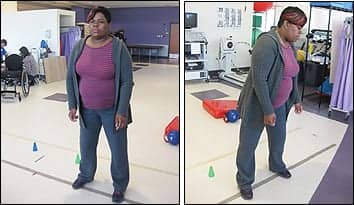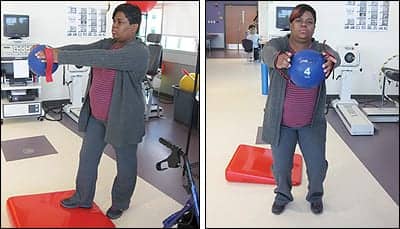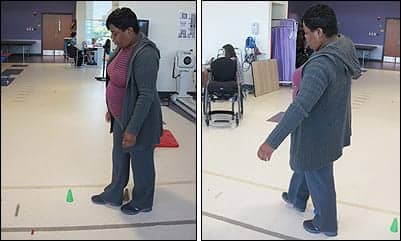The National Spinal Cord Injury Association estimates that 250,000 to 400,000 individuals are living with spinal cord injuries (SCIs) across the world, with approximately 7,800 new injuries occurring every year in the United States alone. A catastrophic injury, SCI causes multisystem changes with far-reaching consequences.
 |
| An assessment of patient Giselle’s standing balance is imperative as part of her gait training regimen. |
Abnormal gait and decreased balance are just two of the numerous impairments that can result from an SCI, but they play a critical role in a patient’s ability to ambulate. At the Kennedy Krieger Institute in Baltimore, staff in the International Center for Spinal Cord Injury (ICSCI) evaluate and treat individuals of all ages for gait and balance disorders, as well as numerous other deficits resulting from SCI. Regardless of the cause of paralysis—accident, stroke, tumor, and birth defects—the goal is always to help the patient recover the ability to perform functional activities, optimize neural recovery, improve their health, and thus enhance the patient’s overall quality of life.
For children and adults who are both acute and chronic, patients at Kennedy Krieger’s ICSCI often have a common desire—to regain the ability to walk or to improve their current walking pattern. That was indeed the goal of patient Giselle, when she came to ICSCI’s outpatient clinic in July 2009, 8 years after transverse myelitis caused her spinal cord injury. At the time, Giselle was ambulating with a rollator walker, but she desired the ability to walk safely without the use of an assistive device. Review of her case study is useful to gain an understanding of the role of evaluating, diagnosing, and treating gait and balance issues in individuals with spinal cord injuries.
As with all patients, Giselle was evaluated by the medical team to ensure that her condition was stable enough, and appropriate for, participation in the program’s activity-based restorative therapy approach. Once cleared for participation by nursing and a physician, a referral was written for formal physical therapy evaluation and treatment, with a focus on gait training.

To learn more about the international center for spinal cord injury at the Kennedy Krieger institute, go to www.spinalcordrecovery.org.
During the initial therapy visit, the evaluating therapist used various tests and measures to identify Giselle’s impairments and generate a problem list for creation of her plan of care. Manual muscle tests, range of motion measurements, tone and posture assessments, and pain scales are utilized to assess musculoskeletal barriers. For gait training, an assessment of standing balance is also imperative. In Giselle’s case, this was completed via the Berg Balance Test, the standing functional reach test, and perturbations created by the therapist. As Giselle was ambulatory upon presenting to the clinic, the following outcome measures were also completed to document quality of gait: 10 meter walk test, 6-minute walk test, dynamic gait index, and gait mapping. Lastly, an over-ground visual gait analysis by the therapist to document deviations is an essential portion of a gait evaluation.
The initial assessment helped to determine that Giselle would indeed benefit from gait and balance retraining in order to improve her mechanics and efficiency of gait. Her physical therapist then discussed goals and plan of care ideas with Giselle, and together they agreed that the focuses of treatment would be related to minimizing the compensations used to walk, increasing walking speed, improving balance to eliminate the need for a walking device, and improving overall endurance. Based on these focus areas, the physical therapist then established both long- and short-term goals to direct Giselle’s plan of care.
 |
| As part of Giselle’s treatment plan in the activity-based restorative therapy, exercises to activate and strengthen weak muscles were implemented. |
The therapist utilized the evaluation findings to determine the best treatment plan and interventions to address the established goals. Therapeutic exercise would be used to strengthen weak muscles. Functional electrical stimulation would be used to retrain weak muscle groups, such as the hamstring and tibialis anterior muscles, in a functional manner during gait and other various functional activities. Locomotor training over the treadmill would be utilized to retrain the patient’s stepping pattern through use of a partial body weight support harness and facilitatory sensory cues over the lower extremity and trunk muscle groups throughout the gait cycle. For example, the hamstring and tibialis anterior are facilitated during swing phase, and the quadriceps and plantar flexors are facilitated during stance phase. The parallel bars would be used to create a safe environment for balance training tasks and pregait activities. Lastly, aquatic therapy would be initiated to utilize the beneficial properties of water: buoyancy, resistance, and thermal effects. Buoyancy provides body weight support that would allow Giselle to activate weak muscle groups and practice improved gait pattern, while creating a safe environment for challenging her balance. The resistance would allow strengthening of weak muscle groups and challenges to resistance, while the increased temperature of the water would decrease tone, allowing Giselle to activate underlying muscle groups.
Abnormal lower extremity tone was labeled as a significant contributor to Giselle’s impaired gait pattern through observation of the treating therapist. As nonmedical approaches were insufficient to limit this tone, the physical therapist collaborated with the medical team to determine the best tone management plan, which began with baclofen. Because baclofen had limited effectiveness on decreasing tone for Giselle, the physician and therapist then decided to trial onabotulinumtoxinA injections to the muscle groups that were impairing her gait the most. This resulted in slight relief in her lower extremity tone.
As an adult, the approach to Giselle’s treatment differs somewhat from the approach to a child. When treating a child, one must always consider developmental stages and milestones. Gait training may not always be age-appropriate, and the focus of treatment may need to be related to other milestones, such as crawling or rolling. With a child, one may need to consider starting with or returning to the school environment when creating a plan of care. In that case, therapeutic and equipment recommendations will need to be made to the appropriate service providers to assist with that transition. As a mother of two, Giselle’s plan of care needs to consider her ability to attend school and sporting events, play with her children, and possibly return to work in the future. Gait training should revolve around helping to maximize this independence in the community environment. With young children, educating the parents will be a large portion of training sessions, as they should be instructed on how to assist their children with improving recovery outside of the clinic. The parents will also assist with decisions in representation of their children. With Giselle and other adults, training is focused on motivating her to direct her own recovery outside of the clinic and how to safely use the equipment she needs to progress her recovery.
 |
| The focus of Giselle’s treatment was to minimize her reliance on a walking device, increase her walking speed, and improve her balance and overall endurance. |
A similarity between treating adults and pediatric patients is the process to ensure financial reimbursement for services rendered. Insurance companies require detailed documentation of interventions used during each session and explanation of patient performance to remit payment. Each intervention falls under a specific code to represent the various services utilized in a session. It is important that the treating therapist take the time to accurately bill services under the various codes at the end of each session. Billing must be supported by daily notes written by the physical therapist. In addition, progress toward goals and formal updates of patient status need to be assessed and documented in order to continue coverage of services provided. In the state of Maryland (home of Kennedy Krieger Institute), physical therapists are required to reevaluate patients every 30 days to assess improvements in patient status. Monthly reevaluations are provided to the insurance company, after they have been signed by the primary physician, to serve as evidence of progress made. Without proof of improvement or signs of progress toward goals, the insurance company can discontinue payment and patients would need to be discharged.
Since participating in the outpatient program at ICSCI, Giselle has progressed from ambulating in the community with a rolling walker to ambulating with bilateral straight canes. She has demonstrated improved safety awareness, efficiency of gait, and balance. She has improved her self-confidence to a level that allows her to interact within her community much more than she has since the injury occurred. Giselle is now able to attend her children’s sporting events and run daily errands with a greater sense of comfort. This improvement in quality of life is what the rehabilitation team at ICSCI strives to achieve for each individual patient who participates in our program.
Erin E. Michael, PT, DPT, is a physical therapist in the International Center for Spinal Cord Injury at Kennedy Krieger Institute in Baltimore. A graduate of Ithaca College, she holds both Master’s and Doctorate of physical therapy degrees. Kelly M. Joslyn, PT, DPT, a graduate of Emory University, is a physical therapist in the International Center for Spinal Cord Injury.





